Boosting Photocatalytic Performance of ZnO Nanowires via Building Heterojunction with g-C3N4
Abstract
:1. Introduction
2. Results and Discussion
2.1. XRD and FT-IR Analysis
2.2. XPS Analysis
2.3. Morphology and Microstructure Analysis
2.4. Analysis of Optical Properties
2.5. N2 Adsorption–Desorption Isotherm Analysis
2.6. Evaluation of Photocatalytic Degradation Performance
2.7. Reusability and Stability of the Composites
2.8. Possible Photodegradation Mechanism
3. Experimental
3.1. Materials
3.2. Preparation of g-C3N4
3.3. Preparation of ZnO NWs
3.4. Preparation of g-C3N4/ZnO NWs
3.5. Characterization
3.6. Photocatalytic Experiment
4. Conclusions
Author Contributions
Funding
Conflicts of Interest
Sample Availability
References
- Feng, L.; Cheng, Y.; Zhang, Y.; Li, Z.; Yu, Y.; Feng, L.; Zhang, S.; Xu, L. Distribution and human health risk assessment of antibiotic residues in large-scale drinking water sources in Chongqing area of the Yangtze River. Environ. Res. 2020, 185, 109386. [Google Scholar] [CrossRef]
- Jiang, X.; Qu, Y.; Zhong, M.; Li, W.; Huang, J.; Yang, H.; Yu, G. Seasonal and spatial variations of pharmaceuticals and personal care products occurrence and human health risk in drinking water—A case study of China. Sci. Total Environ. 2019, 694, 133711. [Google Scholar] [CrossRef]
- Guo, X.; Duan, J.; Li, C.; Zhang, Z.; Wang, W. Highly efficient Z-scheme g-C3N4/ZnO photocatalysts constructed by co-melting-recrystallizing mixed precursors for wastewater treatment. J. Mater. Sci. 2020, 55, 2018–2031. [Google Scholar] [CrossRef]
- Peng, J.; Zhang, B.; Hua, W.; Liang, Y.; Zhang, W.; Du, Y.; Peleckis, G.; Indris, S.; Gu, Q.; Cheng, Z.; et al. A Disordered Rubik’s Cube-Inspired Framework for Sodium-Ion Batteries with Ultralong Cycle Lifespan. Angew. Chem. Int. Ed. 2023, 62, e202215865. [Google Scholar] [CrossRef] [PubMed]
- Peng, J.; Gao, Y.; Zhang, H.; Liu, Z.; Zhang, W.; Li, L.; Qiao, Y.; Yang, W.; Wang, J.; Dou, S.; et al. Ball Milling Solid-State Synthesis of Highly Crystalline Prussian Blue Analogue Na2-x MnFe(CN)6 Cathodes for All-Climate Sodium-Ion Batteries. Angew. Chem. Int. Ed. 2022, 61, e202205867. [Google Scholar] [CrossRef]
- Dutta, M.; Bhattacharjee, S.; De, S. Separation of reactive dyes from textile effluent by hydrolyzed polyacrylonitrile hollow fiber ultrafiltration quantifying the transport of multicomponent species through charged membrane pores. Sep. Purif. Technol. 2020, 234, 116063. [Google Scholar] [CrossRef]
- Shao, L.; Liu, J.; Li, F.; Yang, J.; Zhang, X.; Li, S.; Li, Y.; Sun, P. Preparation and adsorption properties of TiO2/MoS2 nanocomposites. Mater. Res. Express 2019, 6, 055046. [Google Scholar] [CrossRef]
- Huang, Z.-H.; Ji, Z.-Y.; Zhao, Y.-Y.; Liu, J.; Li, F.; Yuan, J.-S. Treatment of wastewater containing 2-methoxyphenol by persulfate with thermal and alkali synergistic activation: Kinetics and mechanism. Chem. Eng. J. 2020, 380, 122411. [Google Scholar] [CrossRef]
- Yi, F.; Gan, H.; Jin, H.; Zhao, W.; Zhang, K.; Jin, H.; Zhang, H.; Qian, Y.; Ma, J. Sulfur- and chlorine-co-doped g-C3N4 nanosheets with enhanced active species generation for boosting visible-light photodegradation activity. Sep. Purif. Technol. 2020, 233, 115997. [Google Scholar] [CrossRef]
- Yuan, Y.-J.; Shen, Z.-K.; Song, S.; Guan, J.; Bao, L.; Pei, L.; Su, Y.; Wu, S.; Bai, W.; Yu, Z.-T.; et al. Co-P Bonds as Atomic-Level Charge Transfer Channel To Boost Photocatalytic H2 Production of Co2P/Black Phosphorus Nanosheets Photocatalyst. ACS Catal. 2019, 9, 7801–7807. [Google Scholar] [CrossRef]
- Wang, J.; Xin, S.; Xiao, Y.; Zhang, Z.; Li, Z.; Zhang, W.; Li, C.; Bao, R.; Peng, J.; Yi, J.; et al. Manipulating the Water Dissociation Electrocatalytic Sites of Bimetallic Nickel-Based Alloys for Highly Efficient Alkaline Hydrogen Evolution. Angew. Chem. Int. Ed. 2022, 61, e202202518. [Google Scholar]
- Jabbar, Z.H.; Graimed, B.H. Recent developments in industrial organic degradation via semiconductor heterojunctions and the parameters affecting the photocatalytic process: A review study. J. Water Process Eng. 2022, 47, 102671. [Google Scholar] [CrossRef]
- Yuan, Y.-J.; Shen, Z.-K.; Wang, P.; Li, Z.; Pei, L.; Zhong, J.; Ji, Z.; Yu, Z.-T.; Zou, Z. Metal-free broad-spectrum PTCDA/g-C3N4 Z-scheme photocatalysts for enhanced photocatalytic water oxidation. Appl. Catal. B Environ. 2020, 260, 118179. [Google Scholar] [CrossRef]
- Isac, L.; Cazan, C.; Enesca, A.; Andronic, L. Copper Sulfide Based Heterojunctions as Photocatalysts for Dyes Photodegradation. Front. Chem. 2019, 7, 694. [Google Scholar] [CrossRef] [Green Version]
- Miyoshi, A.; Nishioka, S.; Maeda, K. Water Splitting on Rutile TiO2-Based Photocatalysts. Chem. Eur. J. 2018, 24, 18204–18219. [Google Scholar] [CrossRef]
- Hussain, T.; Junaid, M.; Qayyum, H.A. Preparation of Ba-doped SrTiO3 photocatalyst by sol-gel method for hydrogen generation. Chem. Phy. Lett. 2020, 754, 137741. [Google Scholar] [CrossRef]
- Hitam, C.N.C.; Jalil, A.A. A review on exploration of Fe2O3 photocatalyst towards degradation of dyes and organic contaminants. J. Environ. Manag. 2020, 258, 110050. [Google Scholar] [CrossRef]
- Sun, Q.; Wang, N.; Yu, J.; Yu, J.C. A Hollow Porous CdS Photocatalyst. Adv. Mater. 2018, 30, 1804368. [Google Scholar] [CrossRef] [PubMed]
- Dutta, V.; Sharma, S.; Raizada, P.; Thakur, V.K.; Khan, A.A.P.; Saini, V.; Asiri, A.M.; Singh, P. An overview on WO3 based photocatalyst for environmental remediation. J. Environ. Chem. Eng. 2021, 9, 105018. [Google Scholar] [CrossRef]
- Rajabi, H.R.; Khani, O.; Shamsipur, M.; Vatanpour, V. High-performance pure and Fe3+-ion doped ZnS quantum dots as green nanophotocatalysts for the removal of malachite green under UV-light irradiation. J. Hazard. Mater. 2013, 250–251, 370–378. [Google Scholar] [CrossRef]
- Karimi, L.; Zohoori, S.; Yazdanshenas, M.E. Photocatalytic degradation of azo dyes in aqueous solutions under UV irradiation using nano-strontium titanate as the nanophotocatalyst. J. Saudi Chem. Soc. 2014, 18, 581–588. [Google Scholar] [CrossRef] [Green Version]
- Wang, Y.; Yang, X.; Lou, J.; Huang, Y.; Peng, J.; Li, Y.; Liu, Y. Enhance ZnO Photocatalytic Performance via Radiation Modified g-C3N4. Molecules 2022, 27, 8476. [Google Scholar] [CrossRef] [PubMed]
- Ismael, M. A review on graphitic carbon nitride (g-C3N4) based nanocomposites: Synthesis, categories, and their application in photocatalysis. J. Alloys Compd. 2020, 846, 156446. [Google Scholar] [CrossRef]
- Devarayapalli, K.C.; Lee, K.; Do, H.B.; Dang, N.N.; Yoo, K.; Shim, J.; Prabhakar Vattikuti, S.V. Mesostructured g-C3N4 nanosheets interconnected with V2O5 nanobelts as electrode for coin-cell-type-asymmetric supercapacitor device. Mater. Today Energy 2021, 21, 100699. [Google Scholar] [CrossRef]
- Vattikuti, S.V.P.; Nam, N.D.; Shim, J. Graphitic carbon nitride/Na2Ti3O7/V2O5 nanocomposite as a visible light active photocatalyst. Ceram. Int. 2020, 46, 18287–18296. [Google Scholar] [CrossRef]
- Mohamed, M.M.; Ghanem, M.A.; Khairy, M.; Naguib, E.; Alotaibi, N.H. Zinc oxide incorporated carbon nanotubes or graphene oxide nanohybrids for enhanced sonophotocatalytic degradation of methylene blue dye. Appl. Surf. Sci. 2019, 487, 539–549. [Google Scholar] [CrossRef]
- Li, H.; Ding, J.; Cai, S.; Zhang, W.; Zhang, X.; Wu, T.; Wang, C.; Foss, M.; Yang, R. Plasmon-enhanced photocatalytic properties of Au/ZnO nanowires. Appl. Surf. Sci. 2022, 583, 152539. [Google Scholar] [CrossRef]
- Habba, Y.G.; Capochichi-Gnambodoe, M.; Leprince-Wang, Y. Enhanced Photocatalytic Activity of Iron-Doped ZnO Nanowires for Water Purification. Appl. Sci. 2017, 7, 1185. [Google Scholar] [CrossRef] [Green Version]
- Braiek, Z.; Roques-Carmes, T.; Assaker, I.B.; Gannouni, M.; Arnoux, P.; Corbel, S.; Chtourou, R. Enhanced solar and visible light photocatalytic activity of In2S3-decorated ZnO nanowires for water purification. J. Photochem. Photobiol. A Chem. 2019, 368, 307–316. [Google Scholar] [CrossRef]
- Liu, S.; Zhu, H.; Yao, W.; Chen, K.; Chen, D. One step synthesis of P-doped g-C3N4 with the enhanced visible light photocatalytic activity. Appl. Surf. Sci. 2018, 430, 309–315. [Google Scholar] [CrossRef]
- Yang, H.; Jin, Z.; Hu, H.; Lu, G.; Bi, Y. Fivefold Enhanced Photoelectrochemical Properties of ZnO Nanowire Arrays Modified with C3N4 Quantum Dots. Catalysts 2017, 7, 99. [Google Scholar] [CrossRef] [Green Version]
- Dong, P.; Yang, B.; Liu, C.; Xu, F.; Xi, X.; Hou, G.; Shao, R. Highly enhanced photocatalytic activity of WO3 thin films loaded with Pt-Ag bimetallic alloy nanoparticles. RSC Adv. 2017, 7, 947–956. [Google Scholar] [CrossRef] [Green Version]
- Khaing, K.K.; Yin, D.; Ouyang, Y.; Xiao, S.; Liu, B.; Deng, L.; Li, L.; Guo, X.; Wang, J.; Liu, J.; et al. Fabrication of 2D–2D Heterojunction Catalyst with Covalent Organic Framework (COF) and MoS2 for Highly Efficient Photocatalytic Degradation of Organic Pollutants. Inorg. Chem. 2020, 59, 6942–6952. [Google Scholar] [CrossRef] [PubMed]
- Vijayakumar, T.P.; Benoy, M.D.; Duraimurugan, J.; Suresh Kumar, G.; Shkir, M.; Maadeswaran, P.; Senthil Kumar, A.; Ramesh Kumar, K.A. Hydrothermal synthesis of CuO/g-C3N4 nanosheets for visible-light driven photodegradation of methylene blue. Diam. Relat. Mater. 2022, 121, 108735. [Google Scholar] [CrossRef]
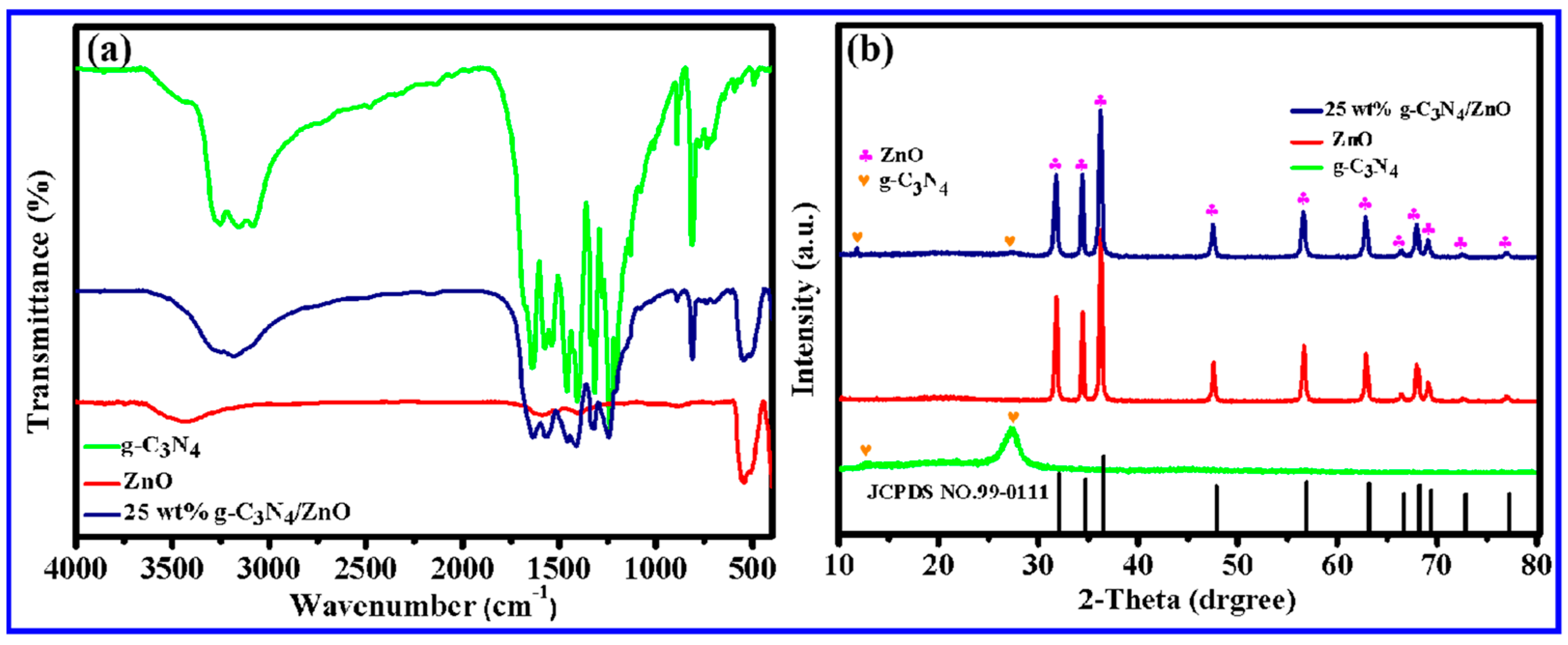
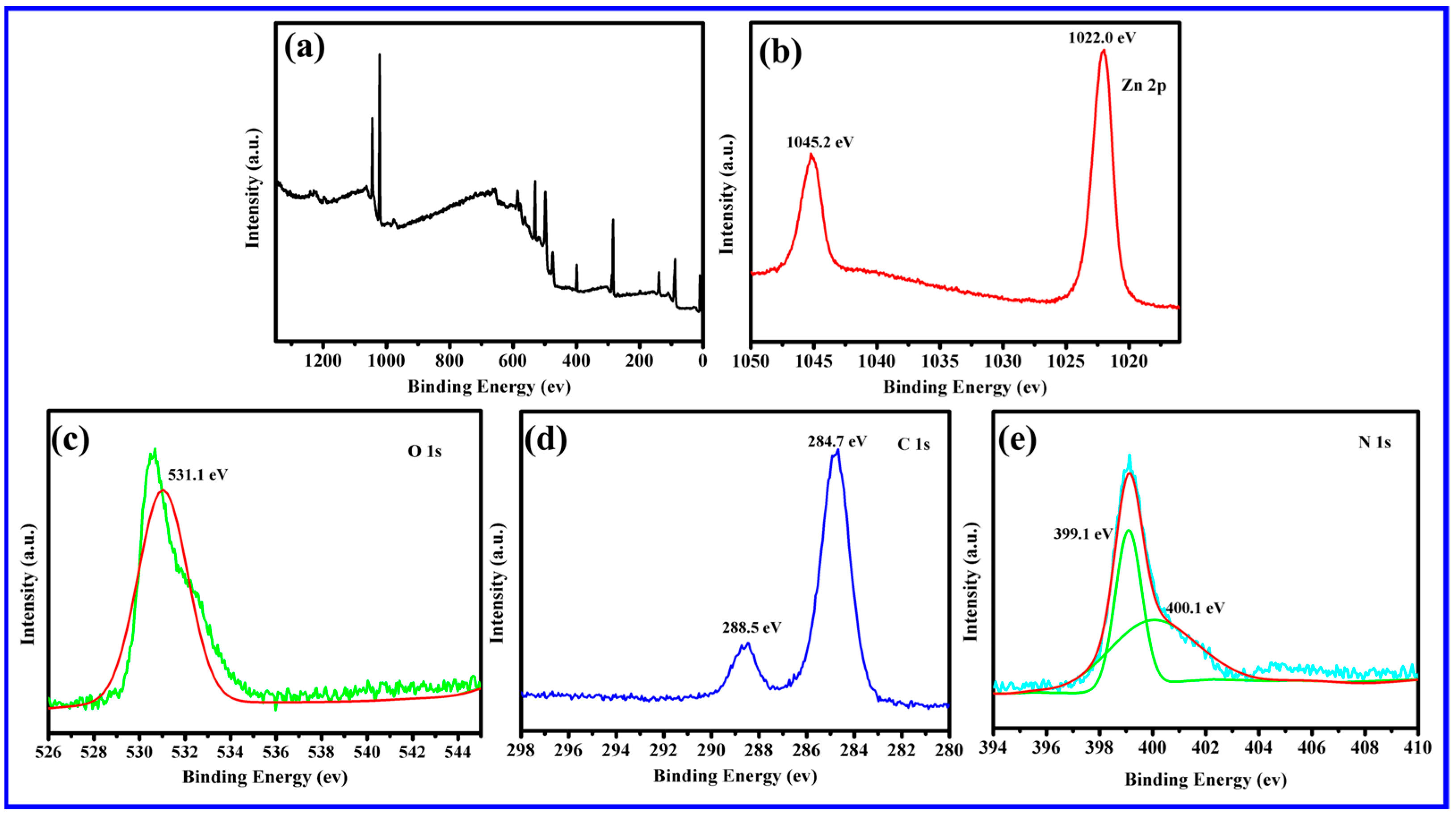


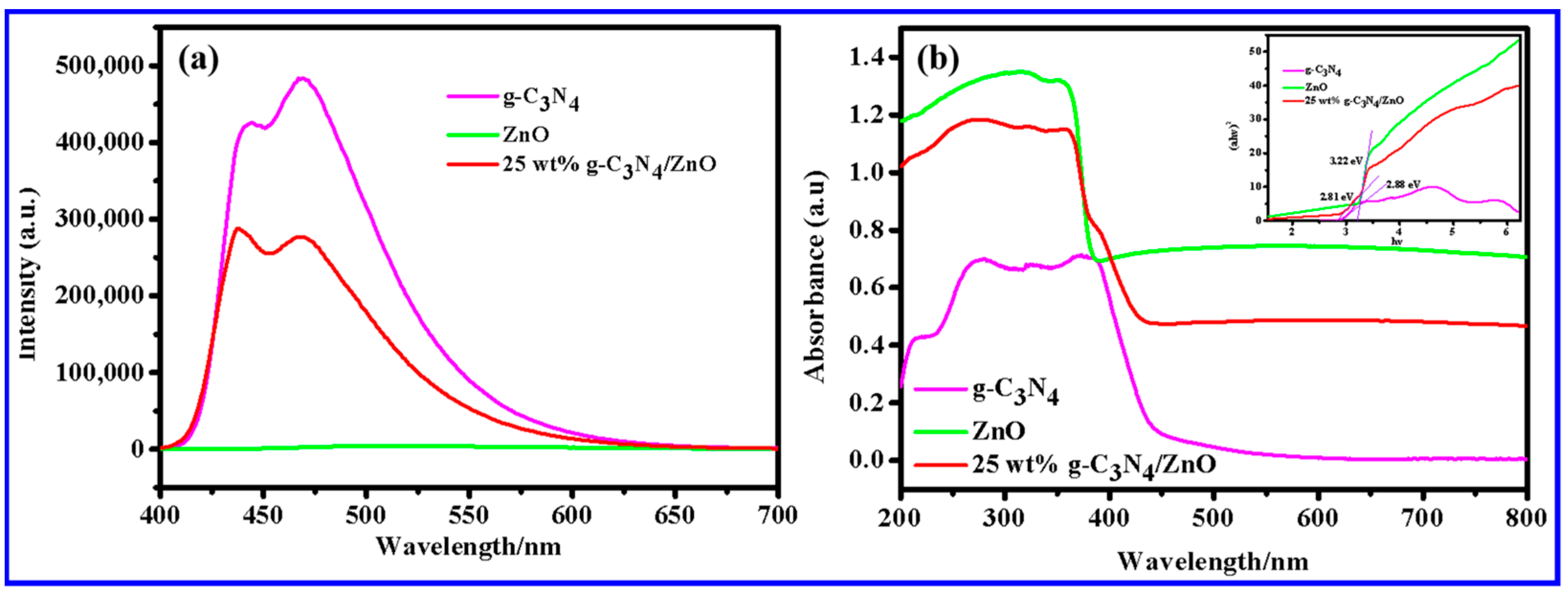
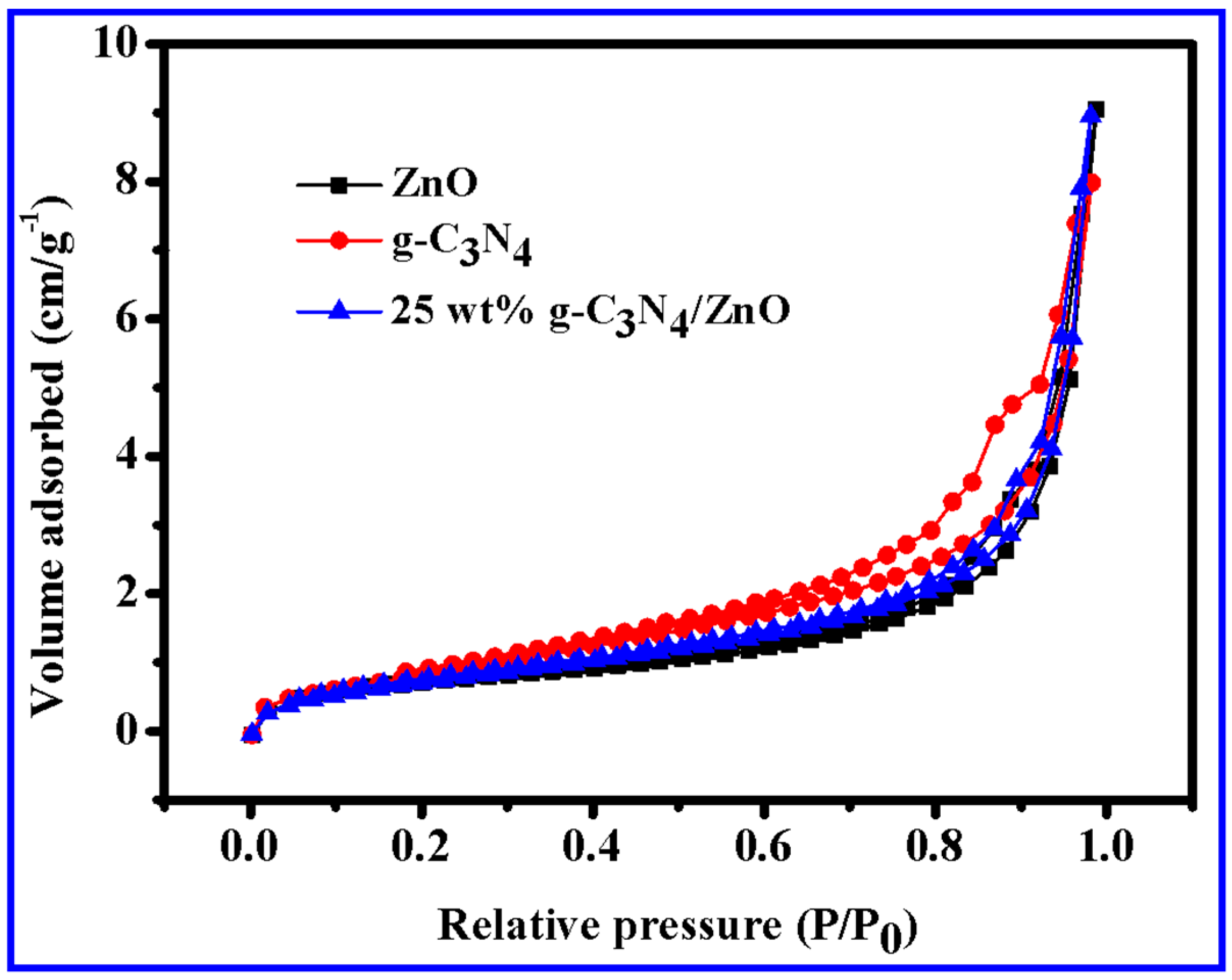

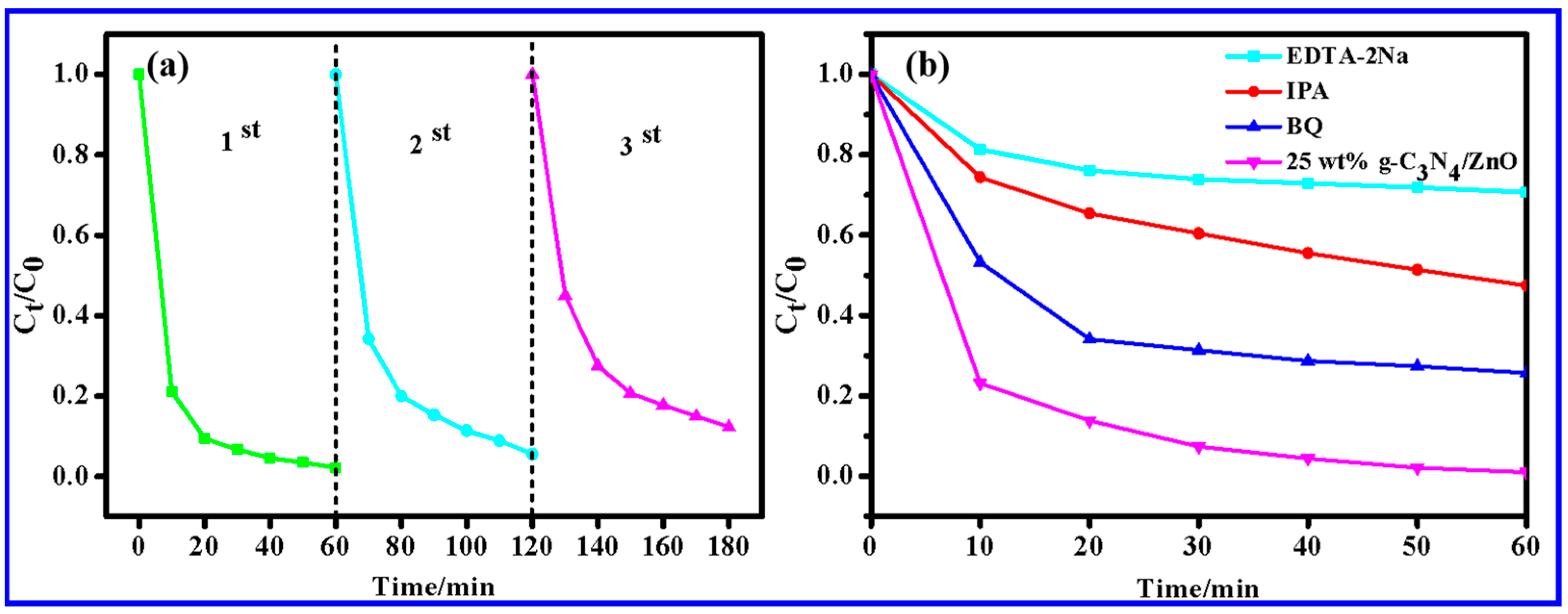

| Y = ln(C0/Ct) | R2 | Degradation Rate (%) | |
|---|---|---|---|
| g-C3N4 | Y = 0.00653X | 0.98 | 35.21 |
| ZnO | Y = 0.03886X | 0.96 | 87.53 |
| 10 wt% g-C3N4/ZnO | Y = 0.04498X | 0.96 | 90.82 |
| 15 wt% g-C3N4/ZnO | Y = 0.05332X | 0.98 | 94.80 |
| 20 wt% g-C3N4/ZnO | Y = 0.05691X | 0.98 | 95.55 |
| 25 wt% g-C3N4/ZnO | Y = 0.08045X | 0.99 | 99.07 |
| 30 wt% g-C3N4/ZnO | Y = 0.05156X | 0.98 | 93.99 |
Disclaimer/Publisher’s Note: The statements, opinions and data contained in all publications are solely those of the individual author(s) and contributor(s) and not of MDPI and/or the editor(s). MDPI and/or the editor(s) disclaim responsibility for any injury to people or property resulting from any ideas, methods, instructions or products referred to in the content. |
© 2023 by the authors. Licensee MDPI, Basel, Switzerland. This article is an open access article distributed under the terms and conditions of the Creative Commons Attribution (CC BY) license (https://creativecommons.org/licenses/by/4.0/).
Share and Cite
Wang, Y.; Liu, Z.; Li, Y.; Yang, X.; Zhao, L.; Peng, J. Boosting Photocatalytic Performance of ZnO Nanowires via Building Heterojunction with g-C3N4. Molecules 2023, 28, 5563. https://doi.org/10.3390/molecules28145563
Wang Y, Liu Z, Li Y, Yang X, Zhao L, Peng J. Boosting Photocatalytic Performance of ZnO Nanowires via Building Heterojunction with g-C3N4. Molecules. 2023; 28(14):5563. https://doi.org/10.3390/molecules28145563
Chicago/Turabian StyleWang, Yayang, Ziyi Liu, Yuesheng Li, Xiaojie Yang, Lingfei Zhao, and Jian Peng. 2023. "Boosting Photocatalytic Performance of ZnO Nanowires via Building Heterojunction with g-C3N4" Molecules 28, no. 14: 5563. https://doi.org/10.3390/molecules28145563
APA StyleWang, Y., Liu, Z., Li, Y., Yang, X., Zhao, L., & Peng, J. (2023). Boosting Photocatalytic Performance of ZnO Nanowires via Building Heterojunction with g-C3N4. Molecules, 28(14), 5563. https://doi.org/10.3390/molecules28145563








